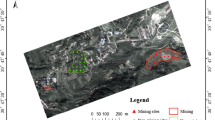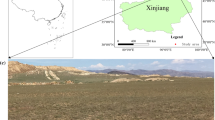Abstract
The special physical and chemical properties of the reclaimed land caused by the disturbance of rare earth mining and the environmental stress caused by the mining of rare earth lead to the inhibition of the physiological functions of the reclaimed vegetation and the severe challenge of vegetation ecological restoration. This study focuses on the Lingbei rare earth mining area in Dingnan County, Jiangxi Province, and investigates the original spectrum, derivative spectrum, and the continuum-removed spectrum of reclaimed vegetation. The spectral characteristics and trends and the typical reclaimed vegetation are analyzed, the correlation between the chlorophyll content and the spectral indices of the reclaimed vegetation is determined, and the sensitive spectral parameters are extracted. Partial least squares algorithm, a back propagation neural network algorithm, and a sparse autoencoder network are used to estimate the chlorophyll content, and the model’s accuracies are compared. The vegetation spectrum of the reclaimed vegetation is characterized by high reflectance in the visible region, a redshift of the green peak and red valley positions, and a blueshift of the red edge positions, a relatively low spectral variation in. The variability of the sensitive spectral parameters of different vegetation type is extracted. The sparse autoencoder network is the optimal estimation model (the R2 value of the three vegetations are 0.9117, 0.7418, and 0.9815, respectively). The results provide a scientific basis for monitoring and managing the growth of different types of reclaimed vegetation in rare earth mining areas under environmental stress and can guide the ecological restoration of reclaimed mining areas.









Similar content being viewed by others
Data availability
The datasets used or analyzed during the current study are available from the corresponding author on reasonable request.
References
Chen L, Huang JF, Wang FM (2007) Comparison between back propagation neural network and regression models for the estimation of pigment content in rice leaves and panicles using hyperspectral data. International Journal of Remote Sensing 28(16):3457–3478
Cui S, Zhou K, Ding R (2019) Extraction of plant anomaly information from hyperspectral data in mining area. Spectroscopy and spectral analysis 39(01):241–249
Feng W (2007) Study on monitoring wheat nitrogen nutrition and growth index based on hyperspectral remote sensing. Nan**g Agricultural University
Flynn KC, Frazier AE, Admas S (2020) Nutrient prediction for tef (Eragrostis tef) plant and grain with hyperspectral data and partial least squares regression: replicating methods and results across environments. Remote Sensing 12(18):2867
Gong Z, Zhao Y, Zhao W, Lin C, Cui T (2014) Estimation model of plant leaf chlorophyll content based on spectral index. Acta Ecologica Sinica 34(20):5736–5745
Guo C, Guo X (2016) Estimation of wetland plant leaf chlorophyll based on the envelope removal of visible light band. Acta Ecologica Sinica 36(20):6538–6546
Huang Z, Turner BJ, Dury SJ (2004) Estimating foliage nitrogen concentration from HYMAP data using continuum removal analysis. Remote Sensing of Environment 93(1-2):18–29
Hao X, Wang D, Wang P (2015) Evaluation of water quality in surface water and shallow ground water: a case study of a rare earth mining area in southern Jiangxi Province, China. Environmental Monitoring and Assessment 188(1):1–11
Hengkai L, Feng X, Qin L (2020) Remote sensing monitoring of land damage and restoration in rare earth mining areas in 6 counties in southern Jiangxi based on multisource sequential images. Journal of Environmental Management 267:110653
Huang L, Zhang H, Ding W (2019) Monitoring of wheat scab using the specific spectral index from ASD hyperspectral dataset. Journal of Spectroscopy 2019:1–9. https://doi.org/10.1155/2019/9153195
Li F (2016) Quantitative estimation of leaf nitrogen in winter wheat by hyperspectral data and satellite image in Guanzhong area. Northwest A&F University
Liu ML, Liu XN, Li T, **u LN (2010) Spectral singularity analysis of rice zinc pollution stress. Transactions of the Chinese Society of Agricultural Engineering 26(03):191–197
Liu N, **ng Z, Zhao R (2020) Analysis of chlorophyll concentration in potato crop by coupling continuous wavelet transform and spectral variable optimization. Remote Sensing. 12(17):2826
Luo D, Chang Q, Qi Y, Li Y, Li S (2016) Study on estimation model of winter wheat canopy chlorophyll content based on spectral index. Acta Triticeae Sinica 36(09):1225–1233
Lu B, Dao PD, Liu J (2020) Recent advances of hyperspectral imaging technology and applications in agriculture. Remote Sensing 12(16):2659
Li H, Wei Z, Wang X (2020) Spectral characteristics of reclaimed vegetation in a rare earth mine and analysis of its correlation with the chlorophyll content. Journal of Applied Spectroscopy 87(3):553–562
Mahajan GR, Pandey RN, Sahoo RN (2017) Monitoring nitrogen, phosphorus and sulphur in hybrid rice (Oryza sativa L.) using hyperspectral remote sensing. Precision agriculture 18(5):736–761
Ou B (2018) Study on extraction of spectral characteristics of vegetation and retrieval of chlorophyll content in reclaimed ionized rare earth mining area. Jiangxi University of Science and Technology
Peng Y, He GJ, Zhang ZM (2016) Remote sensing dynamic monitoring and evaluation of the ecological environment of the rare earth mining development zone in southern Jiangxi. Acta Ecologica Sinica 36(3):1676–1685
Peng W (2019) Prediction of the chlorophyll content in pomegranate leaves based on digital image processing technology and stacked sparse autoencoder. International Journal of Food Properties 22(1):1720–1732
Qiao X, Ma S, Hou H, Hao R (2018) Hyperspectral characteristics of plant heavy metal pollution in mining area and its inversion model. Journal of Safety and Environment 18(01):335–341
Shi B, Zhang X, Bai X (2015) Estimation model of chlorophyll in Pinus tabulaeformis forest based on “trilateral” parameters. Journal of Northeast Forestry University 43(5):80–83
Wang F, Gao J, Zha Y (2018) Hyperspectral sensing of heavy metals in soil and vegetation: feasibility and challenges. ISPRS Journal of Photogrammetry and Remote Sensing 136(2):73–84
Wang H, Zeng L, Sun Y (2017) Spectral characteristics of wheat canopy reflectance under heavy metal copper and zinc stress. Transactions of the Chinese Society of Agricultural Engineering 33(02):171–176
Wang L, Lei S, Bian Z (2019) Hyperspectral characteristics analysis of typical plants in different stress areas of semi-arid coal mining collapse. Spectroscopy and Spectral Analysis 39(01):216–222
Yao X, Ren H, Cao Z (2014) Detecting leaf nitrogen content in wheat with canopy hyper spectrum under different soil backgrounds. International Journal of Applied Earth Observation & Geoinformation 2014(32):114–124
You M (2018) Study on physical and chemical parameters estimation model of winter rape based on hyperspectral parameters. Northwest A&F University
Yu X, Lu H, Liu Q (2018)Deep-learning-based regression model and hyperspectral imaging for rapid detection of nitrogen concentration in oilseed rape (Brassica napus L.) leaf. Chemometrics and Intelligent Laboratory Systems 172:188–193
Zhang D, Tashpolat T, Zhang F, Kerimu A (2014) Application of fractional differential in preprocessing hyperspectral data of saline soil. Transactions of the Chinese Society of Agricultural Engineering 30(24):151–160
Zhao, Hengqian, & Zhang, Wenbo. (2018). Analysis on susceptibility of vegetation canopy spectra in coal mining area to land reclamation. Spectroscopy and Spectral Analysis, 39(06).
Zhu, Y. Q. Qu, Y. H., & Liu, S. H. (2014). Spectral response of wheat and lettuce to copper pollution Journal of Remote Sensing, 1 8(2): 335–352.
Zheng Y, Chang Q, Wang T, Yang J (2019) The SPAD hyperspectral estimation of rape based on continuum removal and partial least square regression. Journal of Northwest Sci-tech University of Agriculture and Forestry (Natural Science Edition) 47(08):37–45
Funding
This study was supported by the National Natural Science Foundation, China, under Grant 42161057; and in part by the Analysis and Discrimination of Spectral Characteristics of Reclamation Vegetation in Rare Earth Mining Areas by Star-Earth Synergy XY2021-S035.
Author information
Authors and Affiliations
Contributions
Hengkai Li conceived the research and wrote most of the manuscript. Beibei Zhou improved the manuscript and assisted in the subsequent revision of the article. Feng Xu improved the preliminary manuscript and assisted in the subsequent revision of the article. Zhian Wei checked and perfected the whole paper. All authors have read and approved the manuscript.
Corresponding author
Ethics declarations
Competing interests
The authors declare no competing interests.
Additional information
Responsible Editor: Philippe Garrigues
Publisher’s note
Springer Nature remains neutral with regard to jurisdictional claims in published maps and institutional affiliations.
Rights and permissions
About this article
Cite this article
Li, H., Zhou, B., Xu, F. et al. Hyperspectral characterization and chlorophyll content inversion of reclaimed vegetation in rare earth mines. Environ Sci Pollut Res 29, 36839–36853 (2022). https://doi.org/10.1007/s11356-021-16772-4
Received:
Accepted:
Published:
Issue Date:
DOI: https://doi.org/10.1007/s11356-021-16772-4




